投资学博迪中文版
- 格式:pdf
- 大小:5.12 MB
- 文档页数:44
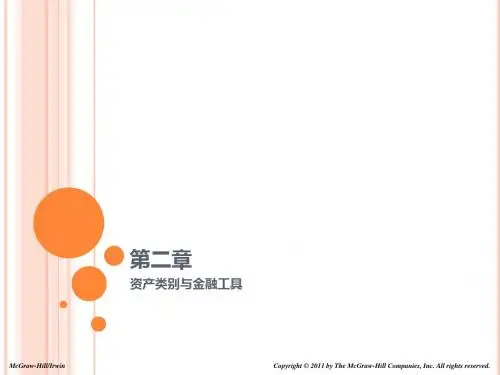
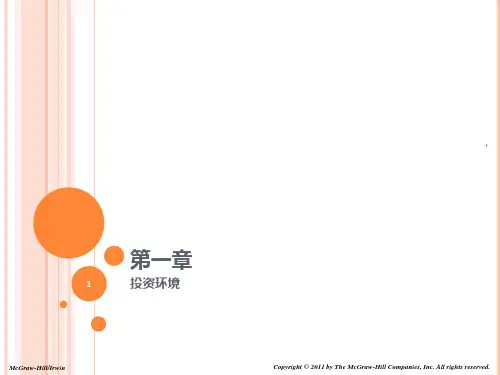
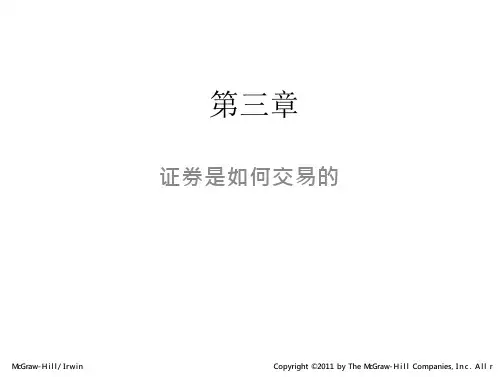
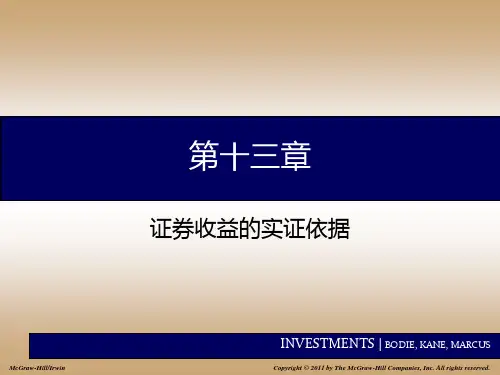
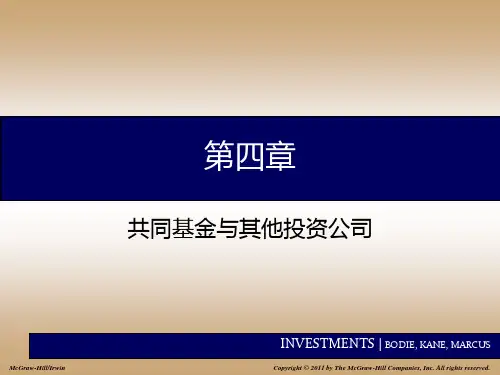
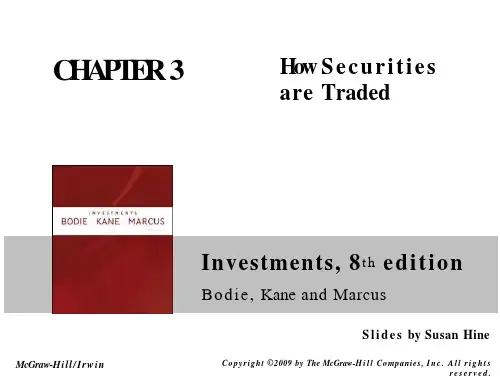

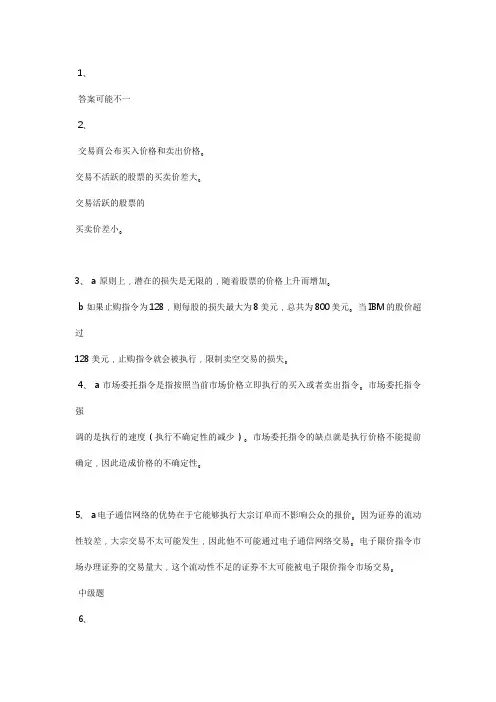
1、答案可能不一2、交易商公布买入价格和卖出价格。
交易不活跃的股票的买卖价差大。
交易活跃的股票的买卖价差小。
3、 a 原则上,潜在的损失是无限的,随着股票的价格上升而增加。
b 如果止购指令为128,则每股的损失最大为8美元,总共为800美元。
当IBM的股价超过128美元,止购指令就会被执行,限制卖空交易的损失。
4、 a 市场委托指令是指按照当前市场价格立即执行的买入或者卖出指令。
市场委托指令强调的是执行的速度(执行不确定性的减少)。
市场委托指令的缺点就是执行价格不能提前确定,因此造成价格的不确定性。
5、 a电子通信网络的优势在于它能够执行大宗订单而不影响公众的报价。
因为证券的流动性较差,大宗交易不太可能发生,因此他不可能通过电子通信网络交易。
电子限价指令市场办理证券的交易量大,这个流动性不足的证券不大可能被电子限价指令市场交易。
中级题6、a 股票购买价格为:300*$40=$12000.借款为$4000,因此投资者权益(保证金)为:$8000 b 股票的价值为:300*$30=$9000。
年末借款变为:$4,000 × 1.08 = $4,320。
因此,投资者账户中的剩余保证金为:$9,000 − $4,320 = $4,680,则保证金比例为:$4,680/$9,000 = 0.52 = 52%,因此投资者不会收到保证金催缴通知。
c投资收益率=(期末权益-期初权益)/期初权益=($4,680 − $8,000)/$8,000 = −0.415 = −41.5%7、 a 期初保证金是:0.50 × 1,000 × $40 = $20,000。
股票价格上涨,则投资者损失为:$10 × 1,000 = $10,000。
此外,投资者必须支付股利:$2 × 1,000 = $2,000,所以,剩余保证金为:$20,000 – $10,000 – $2,000 = $8,000。
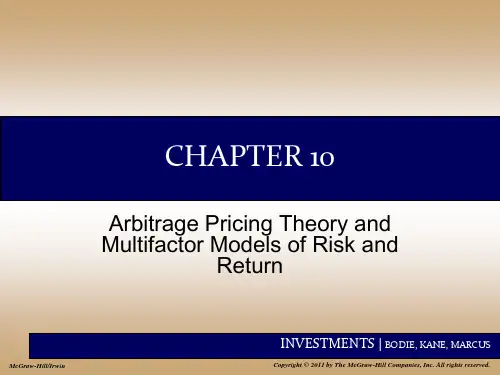
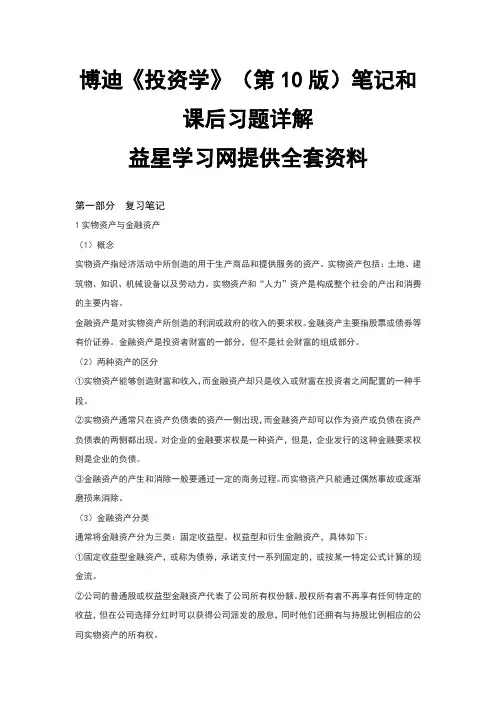
博迪《投资学》(第10版)笔记和课后习题详解益星学习网提供全套资料第一部分复习笔记1实物资产与金融资产(1)概念实物资产指经济活动中所创造的用于生产商品和提供服务的资产。
实物资产包括:土地、建筑物、知识、机械设备以及劳动力。
实物资产和“人力”资产是构成整个社会的产出和消费的主要内容。
金融资产是对实物资产所创造的利润或政府的收入的要求权。
金融资产主要指股票或债券等有价证券。
金融资产是投资者财富的一部分,但不是社会财富的组成部分。
(2)两种资产的区分①实物资产能够创造财富和收入,而金融资产却只是收入或财富在投资者之间配置的一种手段。
②实物资产通常只在资产负债表的资产一侧出现,而金融资产却可以作为资产或负债在资产负债表的两侧都出现。
对企业的金融要求权是一种资产,但是,企业发行的这种金融要求权则是企业的负债。
③金融资产的产生和消除一般要通过一定的商务过程。
而实物资产只能通过偶然事故或逐渐磨损来消除。
(3)金融资产分类通常将金融资产分为三类:固定收益型、权益型和衍生金融资产,具体如下:①固定收益型金融资产,或称为债券,承诺支付一系列固定的,或按某一特定公式计算的现金流。
②公司的普通股或权益型金融资产代表了公司所有权份额。
股权所有者不再享有任何特定的收益,但在公司选择分红时可以获得公司派发的股息,同时他们还拥有与持股比例相应的公司实物资产的所有权。
③衍生证券(如期权和期货合约)的收益取决于其他资产(如股票和债券)的价格。
2金融市场(1)金融市场与经济①金融市场的概念金融市场是指以金融资产为交易对象而形成的供求关系及其机制的总和。
它包括三层含义:一是它是金融资产进行交易的一个有形和无形的场所;二是它反映了金融资产的供应者和需求者之间所形成的供求关系;三是它包含了金融资产交易过程中所产生的运行机制。
②金融市场的作用a.金融市场在资本配置方面起着关键作用,股票市场上的投资者最终决定了公司的存亡。
b.金融市场允许人们通过金融资产储蓄财富,使人们的消费与收入在时间上分离。
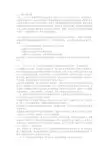
基础题1、单位投资信托基金的运营费用应该较低。
因为一旦信托设立,信托投资组合是固定的,当市场改变时,它不需要支付投资组合经理不断监控和调整投资者组合的费用。
因为投资组合是固定的,所以单位投资信托基金几乎没有交易成本。
2、a单位信托基金:大规模投资的多元化,大规模交易的低成本,低管理费用,可预测的投资组合成分,投资组合的低换手率。
b开放式基金:大规模投资的多元化,大规模交易的低成本,专业的管理可以实现在机会出现时的买入或卖出,记录交易过程。
c个人自主选择的股票和债券:没有管理费用,在协调个人所得税的情况下实现资本利得或者损失,可以根据个人风险偏好来设计投资组合。
3、开放式基金是有义务以资产净值赎回投资者的股票,因此必须保持手头现金及现金证券以满足潜在的赎回。
封闭式基金不需要现金储备,因为对封闭式基金不能赎回。
封闭式基金的投资者希望套现时,他们会出售股票。
4、平衡基金以相对稳定的比例投资于每个资产类别,供投资者投资整个资产组合时选择使用。
生命周期基金属于平衡基金,其资产配置取决于投资者的年龄构成。
积极的生命周期基金,持有大量的股票,是面向年轻的投资者,而保守的生命周期基金,则持有大量的债券,主要针对年长的投资者。
相比之下,资产配置基金会根据对每一个板块相对业绩的预测而显著改变基金在每一个市场的资产配置比例。
因此资产配置资金更强调市场时机的选择。
5、与开放式基金不同,其基金股份随时准备以资产净值赎回,封闭式基金作为一种证券在交易所中交易,因此,它的价格可以偏离它的净值。
6、交易所交易基金的优势:交易所交易基金持续地交易,并且可以通过保证金来购买和出售当交易所交易基金出售时,没有资本利得税(股票只是从一个投资者转移到了另一个投资者)投资者直接从经纪人处购买,从而基金节省了直接向小投资者销售的成本,这种费用降低了管理费用。
交易所交易基金的劣势:价格可能偏离资产净值(不像开放式基金)在从经纪人手中购买时,必须支付费用(不像免佣基金)中级题7、发行价格包括6%的前端费用,也即销售费用,意味着每一美元的支付,仅能得到$0.94的股票净值。
博迪投资学第九版课件Chap001Chapter 1The Investment EnvironmentThe Investment EnvironmentINVESTMENTS|BODIE, KANE, MARCUSReal Assets Versus Financial Assets ?Real AssetsReal Assets–Determine the productive capacity andnet income of the economyt i f th–Examples: Land, buildings, machines,knowledge used to produce goods andservicesFinancial Assets–Claims on real assetsINVESTMENTS|BODIE, KANE, MARCUSFinancial AssetsThree types:1.Fixed income or debt1Fixed income or debt/doc/c30ecec07c1cfad6185fa718.html mon stock or equity 3.Derivative securitiesINVESTMENTS|BODIE, KANE, MARCUSFixed IncomePayments fixed or determined by aP t fi d d t i d bformulaMoney market debt: short term, highly ?Money market debt:short term highly marketable, usually low credit risk Capital market debt: long term bonds, can be safe or riskyINVESTMENTS|BODIE, KANE, MARCUSCommon Stock and Derivatives ?Common Stock is equity or ownershipCommon Stock is equity or ownershipin a corporation.–Payments to stockholders are not fixed,P t t t kh ld t fi dbut depend on the success of the firm ?Derivatives–Value derives from prices of othersecurities, such as stocks and bonds–Used to transfer riskINVESTMENTS|BODIE, KANE, MARCUSFinancial Markets and the Economy ?Information Role: Capital flows tocompanies with best prospectscompanies with best prospectsConsumption Timing: Use securitiesto store wealth and transferto store wealth and transferconsumption to the futureINVESTMENTS|BODIE, KANE, MARCUSFinancial Markets and theEconomy (Ctd.)Allocation of Risk: Investors can select securities consistent with their tastesfor riskfor riskSeparation of Ownership andg y Management: With stability comes agency problemsINVESTMENTS|BODIE, KANE, MARCUSFinancial Markets and theEconomy (Ctd.)Corporate Governance and Corporate Ethicsg–Accounting ScandalsExamples –Enron, Rite Aid, HealthSouth –Auditors –watchdogs of the firms Auditors–watchdogs of the firms–Analyst ScandalsArthur Andersen–Sarbanes-Oxley ActTighten the rules of corporate governanceINVESTMENTS|BODIE, KANE, MARCUSThe Investment ProcessAsset allocationChoice among broad asset classes–Choice among broad asset classes ?Security selection–Choice of which securities to hold withinasset class–Security analysis to value securities anddetermine investment attractivenessdetermine investment attractivenessINVESTMENTS|BODIE, KANE, MARCUSMarkets are CompetitiveRisk-Return Trade-OffEfficient Markets–Active ManagementFinding mispriced securitiesFinding mispriced securitiesTiming the marketINVESTMENTS|BODIE, KANE, MARCUSMarkets are Competitive (Ctd.)(Ctd)–Passive ManagementNo attempt to find undervaluedNo attempt to find undervaluedsecuritiesN tt t t ti th k tNo attempt to time the marketo d g a g y d e s ed po t o o ?Holding a highly diversified portfolioINVESTMENTS|BODIE, KANE, MARCUSThe PlayersBusiness Firms–net borrowers Households –net saversGovernments can be both borrowers ?Governments–can be both borrowersand saversINVESTMENTS|BODIE, KANE, MARCUS(Ctd)The Players (Ctd.)Financial Intermediaries: Pool and invest funds–Investment Companies–Banks–Insurance companies–Credit unionsINVESTMENTS|BODIE, KANE, MARCUSUniversal Bank ActivitiesInvestment Banking Commercial Banking g ?Underwrite new stockand bond issues g ?Take deposits and ?Sell newly issued securities to public in p make loans pthe primary marketInvestors trade previously issued securities amongthemselves in thesecondary markets INVESTMENTS |BODIE, KANE, MARCUSFinancial Crisis of 2008Antecedents of the Crisis:–“The Great Moderation”: a time in which theU.S. had a stable economy with low interestrates and a tame business cycle with onlyy y mild recessions–Historic boom in housing marketINVESTMENTS|BODIE, KANE, MARCUSFigure 1.3 The Case‐Shiller Index of U.S.Housing PricesINVESTMENTS|BODIE, KANE, MARCUSChanges in Housing Finance Old Way New Way yLocal thrift institution made mortgage loans to y Securitization: Fannie Mae and Freddie Mac made mortgage loans to homeownersThrift’s major asset:a Mae and Freddie Mac bought mortgage loans and bundled them into Thrift s major asset: a portfolio of long-term mortgage loans large pools ?Mortgage-backed g gThrift’s main liability:depositssecurities are tradable claims against the underlying mortgage pool ?“Originate to hold”underlying mortgage pool“Originate to distribute”INVESTMENTS |BODIE, KANE, MARCUSFigure 1.4 Cash Flows in a MortgagePass‐Through SecurityINVESTMENTS|BODIE, KANE, MARCUSChanges in Housing Finance(Ctd.)At first, Fannie Mae and Freddie MacAt fi t F i M d F ddi M securitized conforming mortgages, which were lower risk and properly documented.?Later, private firms began securitizing ,p g g nonconforming “subprime”loans withg e de au t shigher default risk.–Little due diligencePlaced higher default risk on investors–Placed higher default risk on investors–Greater use of ARMs and “piggyback” loansINVESTMENTS|BODIE, KANE, MARCUS。